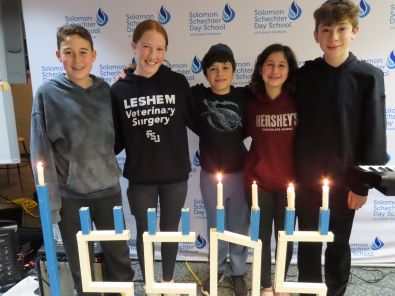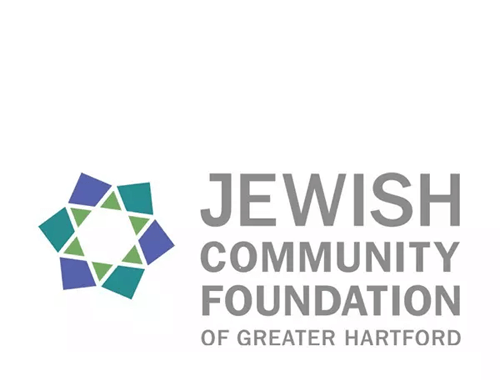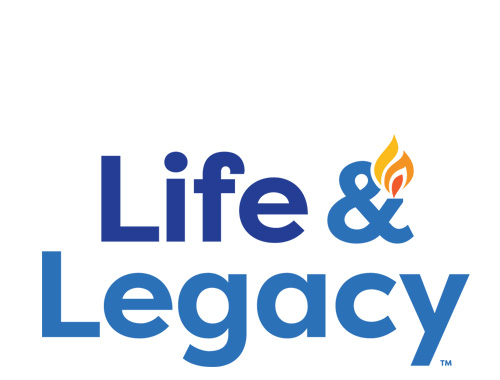Schechter Shavua: December 15, 2023
Robotics Programming with a Festive Hanukkah Twist
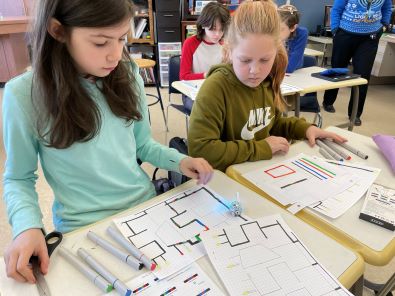 "Oh No! Some of the candles on the Schechter Hanukkiah have gone out--we must be running out of oil!"
"Oh No! Some of the candles on the Schechter Hanukkiah have gone out--we must be running out of oil!"
Meet Evo, a little robot produced by the company Ozobot; it can follow a drawn line or be programmed by reading different color patterns. It also can be programmed using a program called Ozoblockly, which is similar to Scratch. As part of their H anukkah/Makerspace experience, middle school students were challenged to program their Evo to take the flame from the Shamash to the candles of the H anukkiah that have gone out. They used trial and error as their tiny robots made twists and turns along the path of their Hanukkiah. Can they keep the flame lit?
Click HERE to see more photos of Hanukkah Robotics!
Alim Students Dive Deeper into the Hanukkah Story
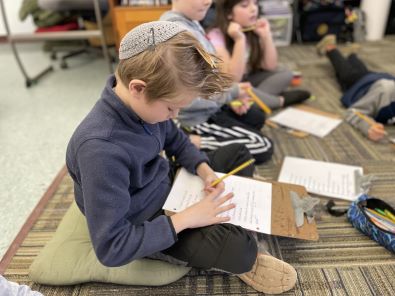 What's Hanukkah all about? Most traditional Jewish sources, from the time of the Talmud onward, focus on the miracle of the light. The main exception is the Al Hanisim prayer whose first sentence became a well-known song. The remainder of the prayer talks about Mattathias and his sons, who fought against the stronger, more numerous Syrian Greeks. At Schechter, Alim students (3rd-4th grades) have been studying the prayer in its original Hebrew to understand the story in greater depth. Students read the text aloud together, and then identified words and grammatical elements that were familiar. They connected those words or fragments to other prayers and discussed their significance. They are emerging with a more thoughtful understanding of the holiday's meaning!
What's Hanukkah all about? Most traditional Jewish sources, from the time of the Talmud onward, focus on the miracle of the light. The main exception is the Al Hanisim prayer whose first sentence became a well-known song. The remainder of the prayer talks about Mattathias and his sons, who fought against the stronger, more numerous Syrian Greeks. At Schechter, Alim students (3rd-4th grades) have been studying the prayer in its original Hebrew to understand the story in greater depth. Students read the text aloud together, and then identified words and grammatical elements that were familiar. They connected those words or fragments to other prayers and discussed their significance. They are emerging with a more thoughtful understanding of the holiday's meaning!
Hanukkah Sand Story Enriches Imaginations
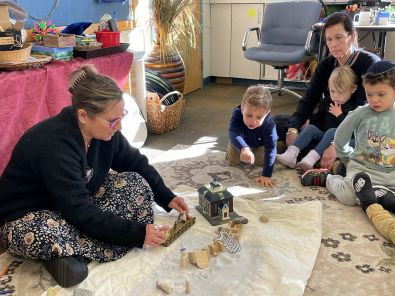 How do we make the holidays come to life for Schechter’s youngest students? Robin Werner, Director of Early Childhood , joined the Shorashim classrooms (EC3-4) to recount the story of Hanukkah through sand stories, which are a unique approach to storytelling. In this approach, artifacts and objects, made of wood, stone, cloth, or sand, are used to help tell stories while the children sit in a storytelling circle. Sand stories invite Early Childhood students into an age-appropriate narrative while leaving room for wonder, creativity, and imagination as they build their own spiritual connection. They were on the edge of their seats wanting to hear about Judah and the Macabees!
How do we make the holidays come to life for Schechter’s youngest students? Robin Werner, Director of Early Childhood , joined the Shorashim classrooms (EC3-4) to recount the story of Hanukkah through sand stories, which are a unique approach to storytelling. In this approach, artifacts and objects, made of wood, stone, cloth, or sand, are used to help tell stories while the children sit in a storytelling circle. Sand stories invite Early Childhood students into an age-appropriate narrative while leaving room for wonder, creativity, and imagination as they build their own spiritual connection. They were on the edge of their seats wanting to hear about Judah and the Macabees!
Students Keep Israel in their Thoughts at Hanukkah
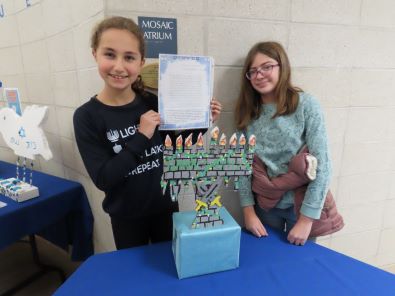 Middle school students have been working to create special H anukkiot that represent the theme of Israel. Each student created their own H anukkiah, using recycled or repurposed materials they could find at home. They wrote one paragraph in English and another in Hebrew describing how their Hanukkiah relates to Israel. Some creations were fun and whimsical, while others took on a more serious theme. The representations ranged from the Israel flag to the Land of Milk and Honey using Pez dispensers as candle holders to depictions of falafel candles in a pita, and themes of war and peace.
Middle school students have been working to create special H anukkiot that represent the theme of Israel. Each student created their own H anukkiah, using recycled or repurposed materials they could find at home. They wrote one paragraph in English and another in Hebrew describing how their Hanukkiah relates to Israel. Some creations were fun and whimsical, while others took on a more serious theme. The representations ranged from the Israel flag to the Land of Milk and Honey using Pez dispensers as candle holders to depictions of falafel candles in a pita, and themes of war and peace.
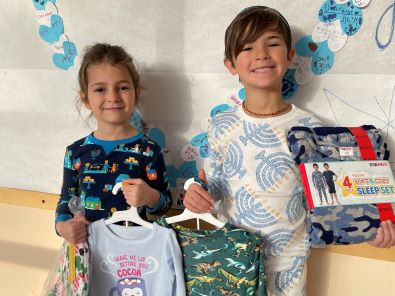
ICYMI: Who knew there were so many different H anukkah pajamas? Click HEREto see photos of Schechter’s PJ fundraiser for Connecticut Children's Medical Center (CCMC)
Shabbat Hanukkah/Parashat Mikketz
 Did Joseph ever change?
Did Joseph ever change?
Our parashahbegins with Joseph’s meteoric rise to power, and ends with his brothers bowing to him, begging for mercy on Benjamin’s behalf. They have clearly changed over time; they are wracked with guilt for having sold Joseph into slavery years earlier. But Joseph doesn’t seem to have changed at all! As a boy, he dreamed that they bowed to him; as an adult, he makes this dream come true. He seems exactly the same.
Our rabbis suggest otherwise. Towards the end of the parashah, before Joseph reveals himself to his brothers, he invites them to eat and drink with him (immo ). Rabbi Levi explains the words “with him” with a poignant midrash: “With him they drank, but away from him, they did not drink. During the entire 22 years that he did not see them, he tasted no wine—and neither did they, until they saw him.”
We understand why the brothers might have abstained; their guilt made them give up wine. But why would Joseph have given up wine? Perhaps because in the bible, wine is associated with joy—and Joseph, despite his amazing rise to power, was never truly happy being apart from his family. Even though they hadn’t yet reconciled, the fact that they were eating together brought him joy. As a child, he separated himself from his brothers; as an adult, he has learned the importance of family.
Hanukkah, like all holidays, can be great for family bonding. At the same time, the story of Joseph reminds us that families can experience painful rifts. May we all be blessed with strong connections to our families—and if we don’t yet have that blessing, may the holidays offer us opportunities to overcome the past and celebrate together.
Shabbat Shalom and Happy Hanukkah,
Rabbi Jonathan Berger
Head of School
Questions for the Shabbat table:
1. Sometimes, we don’t learn to appreciate people until after they are gone. Do you think Joseph would have learned to love his brothers if he hadn’t been separated from them for so many years?
2. On the outside, Joseph didn’t change; as a teenager and as an adult, he liked having people bow to him. But on the inside, according to the midrash, he was a different person. Have you ever felt that way — that people see the “old you,” not the “new you”? Were you able to help people see you as you are?
Solomon Schechter Day School
of Greater Hartford
26 Buena Vista Road
West Hartford, CT 06107
© Solomon Schechter Day School of Greater Hartford | Site design Knowles Kreative
